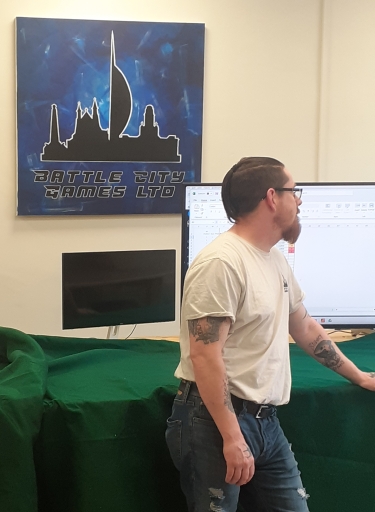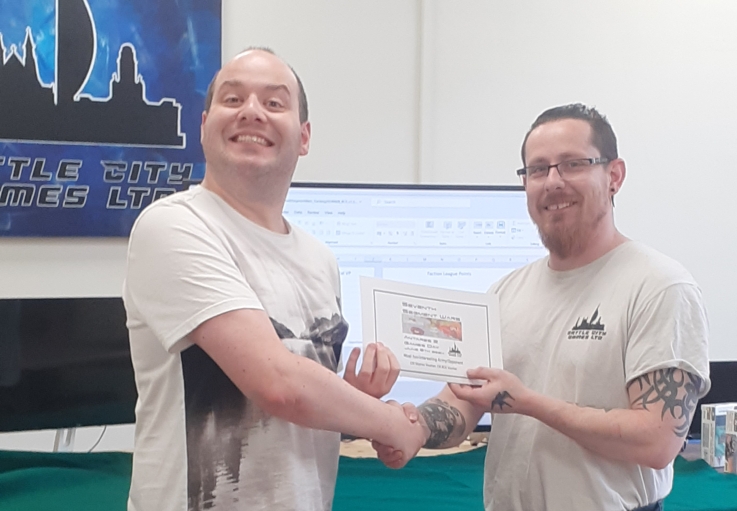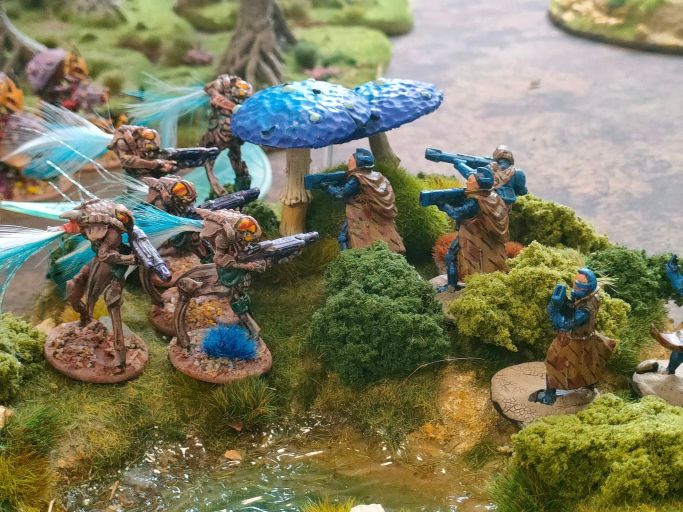Well, the Seventh Segment Wars are Battle City Games (BCG) in Portsmouth on the 8th June, 2024, was a success. Though we had a few – unavoidable – cancellations, those who turned up threw themselves into the games with gusto. All in all, this made it a really enjoyable event!
The theme for the day was that the breakaway NuHu of the Aan Shard have created a weakness in the Southern flank of the PanHuman Concord. The Vorl then seized the opportunity the weakness represents. Would the player’s forcees halt or help the Vorl and the Rogue NuHu of the Aan Shard?
As with many of these games days, if we get enough results from games days held elsewhere in the world, we’ll feed them in to the developing and evolving history of the Antares universe: in this cases, either seeeing the Aan Shard expand, the Vorl expand or the Concord regain their lost territory.
Results
We had three awards on the day plus a raffle for Antares donated by Tim Bancroft, Jamie Morris and – very generously – by Skytrex themselves (for which, many thanks!). These three were given Skytrex vouchers and Dave and Nigel also received BCG vouchers.
- Nigel Bond won the Best Painted Army award for his colourful Vorl and imaginatively decked-out Askar
- Dave Richardson won the Best/Most Fun Opponent award, not just because of the googly eyes on his combat skimmers!
- Dave Richardson also won the ‘I tried really hard’ wooden spoon award for coming last in victory points. His interesting list just couldn;t hack against Vorl and Aan Shard Concord, despite having beaten Vorl regularly in playtesting!




We also have a simple bar chart showing the scores. Note that Vorl and Aan Shard Concord scored roughly the same per army – it’s just that the Vorl had two armies playing!

The Format
The format of the day was that players could choose one of three alliances for whom they would battle: the Loyalist Concord ; the Opportunists; or the breakaway forces of Disorder. The idea is that each alliance will only face forces from another alliance
Lists were tied to an alliance and included all thse for which army supplements are available (see Rules Central) plus the Feral Horde. Force sizes were 60 and 90 points, with players playing 3 out of 6 possible scenarios: the first game at 60pts, FL1; the second an asymmetric game of 60 vs 90; and the final an FL2, 90-pt game. Scenarios were tailored to the theme and included two, completely new (and experimental) evacuation scenarios following the narrative theme of the Vorl and others ravaging human worlds…
Alliance: the Loyalist Concord
The Loyalists consist of those who are implacably anti-Vorl, plus those who are against Rogue NuHu, and those who the Concord had hired or asked to help. Lists under this alliance are:
- PanHuman Concord;
- Freeborn vardosi;
- Algoryn expeditionary forces (SD or AI);
- Feral Horde (mercenaries);
- Boromite (the Vorl are taking their claims!); and
- An Isorian Senatex expeditionary force – not strictly an ally, but hoping to save some humans and establish an Isorian enclave in the area).
Alliance: Vorl & Disorder
This consists of those who have separated from the primary Concord IMTel, such as breakaway Concord, Rogue NuHu and, of course, the Vorl. The forces of Disorder had to be defeated to stabilise the area for the Concord. Lists that fall here were as follows:
- breakaway Aan Shard Concord (a NuHu is mandatory and can substitute in as a selection for a Strike Command);
- Freeborn Rogue NuHu, which has a NuHu by default;
- Vorl.
Alliance: the Opportunists
This represents those factions and forces who are merely taking advantage of the situation to either destabilise the Concord, save the local humans or just reek havoc! The lists in this alliance were:
- Virai;
- Ghar;
- Senatex (who have an option to be Loyalists, if they wish).
How it played
The scenarios were deliberately chosen so that winning wasn;t about wiping your opponent off the map.
The first two were all about movement or preventing movement. One was a simple modifications of the core rules’ scenario 3, ‘An Unexpected Envounter’ (here, ‘Return to Base’) and the second a mix of scenario 7, ‘Critical Control’ and 6, ‘Data Recovery’ (here, ‘Out-manoeuvred’). Of these, one game (Vorl vs Algoryn) looked like an incredible slug match, with the umpire (Tim) stepping in at one point and asking why the players were focused on shooting up each others forces rather than moving off the table. The reply was simple: ‘This is a WAR game!’ The umpire stepped back, only to be asked half an hour later by the Vorl player that they’d “wiped out the Algoryn and the scenario says it ends there”. “Yes,” replied the umpire. “But that means neither of us get any points and it’s a draw.” – “Yes,” said the umpire. “Can I refer you to my previous query?”
Much laughter ensued on behalf of the (defeated) Algoryn player who now had a draw under their belt…
The next two scenarios were asymmetric: 60pts for the defender vs the attackers’ 90pts. One was adapted from scenario 4, ‘Hold the Line’ and scenario 8, ‘Outpost’ (here, ‘A Hasty Defence’) whilst the other was a progressive point control game derived from the Nexus scenario ‘Seizing Control‘ but focusing on points deeper and deeper into the defender’s area of control.
From an umpire’s prespective, it was fascinating seeing how players’ prioritised their forces and objectives in these two scenarios. One player found he had to forego one objective and focus on another, just to get the winning victory points. In another game, the combat turned to close-in fighting, a tough struggle over crucial locations. It’s likely that we might change the VPs for these, but it’s difficult knowing just how well all the combinations of forces stack up against each other.
The last two scenarios were 90 points each, with the defender already established on-table, and were deliberately different and experimental. They were (and still are if you download the pack) the Antares equivalent of non-combatant evacuation operations (NEOs: if you’re really geeky, there is a MOD Joint Doctrine Publication JDP 3-51 on this!). The aim of the first was for the defenders to deploy transmats into buildings so the occupants could evacuate to orbit, whilst the other had the defenders teasing out occupants from buildings so they ran to safety. The attacker had several options: destroy the buildings, destroy the defenders or neutralise the evacuees (send them cowering to the ground) – and it turned out just which option worked best varied substantially by army or even required a mix of these options.
Overall, Vorl did very well – which is interesting, as in playtesting they were beaten, regularly. Another point of note was that the Algoryn’s dual mag cannon approach was desperately unlucky, but could have scarred all the armies of Disorder (as it did in playtesting!).
All in all, a fun day.
Photos of the Day









Running your own Games Day
You can organise your own Seventh Segment games day using the organiser’s pack, downloadable from the link below. This contains a sample player pack, all the scenarios, markers, and a tracking spreadsheet. If you do run a day, do send the results to Tim by contacting him via the Facebook group (https://www.facebook.com/groups/694286423936769/).



You must be logged in to post a comment.